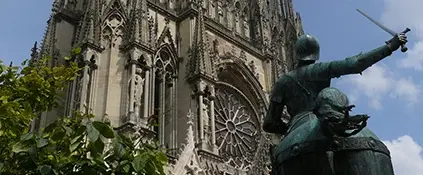Reims was a major commercial crossroads as far back as the Roman times and an important ciy where 25 Kings and Queens of France were corronated. The area surrounding it boasts of 9 Grands Crus villages and provides an ideal cool climate for growing Pinot Noir grapes, owing to its chalky terrain, which includes Ambonnay, Bouzy, Louvois, Mailly, Sillery, Verzenay, Verzy and premier villages Rilly, Ludes, Sacy, Chamery, and Chigny les Roses. A full day itinerary departing from Reims train station or accommodation might look like this:
Visit 1 ▸ Famous Cellar visit and tastings Reims
Visit one of the UNESCO heritage certified gallo-roman cellars of Veuve Clicquot, Ruinart, Taittinger and Pommery for a tour and tasting.
Visit 2 ▸ Premier or Grand Cru Triple Tasting Comparison
The vineyards of Montagne de Reims stretch from Reims to Epernay and are characterized by chalk-based soils where predominant ;y Pinot Noir grapes are cultivated.
Visit 3 ▸ Immersive Visit & Lunch at a Grand Cru Family Vineyard
Enjoy an estate visit and walk in the vines ending with a casual family style meal paired with three single vineyard Grand Cru Pinot Noir cuvées.
Visit 4 ▸ Private vineyard and tasting visit in the Grand Cru village of Bouzy
Bouzy is located on the southern slope of the Montagne de Reims. The village covers 380 hectares mainly planted with Pinot Noir, of which 10% is dedicated to the production of still wine called Bouzy Rouge. Rosé champagnes are either a blend of white Champagne with still Pinot Noir AOC wines or Saigné ( "bleeding") by leaving the grape Musts to macerate for a few hours with the skin of the grapes during pressing

